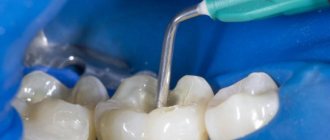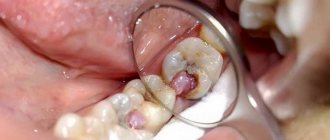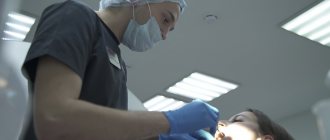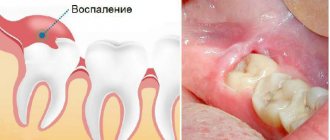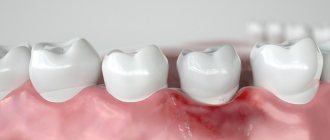Often dental treatment is not limited to just one visit to the doctor - in this case, at an intermediate stage, a temporary filling cannot be avoided. It is mainly used in the following cases:
- Treatment of acute deep caries. The border between dental tissues and the pulp chamber is so thin that the carious process can develop into pulpitis, and then root canal treatment will be required. Therefore, at the first visit, the dentist places a medicinal lining in the tooth and closes the cavity with a temporary filling. If the tooth continues to hurt under it, this indicates the need to change tactics.
- Treatment of pulpitis. In most cases, pulp inflammation is treated in two visits. First, it is necessary to necrotize the vessels and nerves so that later removal of the affected tissue and treatment of the canals will not be painful. To do this, during the first visit, a temporary filling with arsenic is placed.
- Treatment of periodontitis. Depending on the stage of the disease, medicine is placed into the root canals to stop the inflammatory process or to restore bone tissue (when a cyst is removed). In both cases, a temporary filling is needed. At each appointment, the dentist checks the condition of the root canals, as well as the tissues adjacent to it, and decides whether it is possible to permanently fill the tooth or whether it is worth putting a new portion of the drug.
- Preparation for prosthetics. In some situations, a temporary filling is placed on already cured and filled canals - for example, before installing a pin or orthopedic structure.
Use of arsenic in dentistry
The paste, which is based on the oxide of this poison, has a destructive effect. Therefore, it can be used before removing the nerve. What are the properties of the paste?
- It has a fairly high degree of toxicity;
- It acts as a pain reliever;
- The mixture has a pronounced antibacterial effect;
- Its action is prolonged;
After a day or two, arsenic kills the nerve in the tooth. Patients with a low pain threshold do not feel pain during extraction of such a masticatory organ. It happens that the operation is performed after an injection with an anesthetic substance. Most often, the mass is laid for 1-2 days. The duration depends on the complexity of the pathology of the unit. It is extended when the multi-channel unit is disturbed.
To determine the duration of action of the drug, the doctor takes into account its composition. As a rule, more than half of the paste consists of anesthetic components and anhydride, which has a necrotic effect. Also, antiseptics, tannin for binding ingredients, and fillers are added to the mass.
Modern dentistry
Today, arsenic is not used in its pure form, but is included in various devitalizing drugs.
Regardless of their name, the composition is often the same:
- fast-acting anesthetic;
- a substance that allows you to roll the paste into balls;
- antiseptic;
- an astringent component that slows down the absorption of arsenic into the pulp - tannin;
- arsenic anhydride itself.
Indications and contraindications
The paste is used in cases where it is impossible to use modernly produced anesthetics. Such situations occur in certain indications:
- The patient is allergic to other anesthetics;
- If you need to urgently kill nerve fibers and remove a molar;
- When the patient cannot tolerate anesthesia for health reasons;
- Urgent treatment of patients with acute pain;
- Treatment of incisors, canines, molars in childhood when it is impossible to use local anesthesia;
Of course, like every drug, the paste has contraindications. The doctor must take them into account.
- It is impossible to put mass into a pathological tooth if the patient is under two years old.
- Keeping the paste is not allowed in case of chronic kidney disease or prostate disease.
- If the tooth canals are curvature, another remedy is used.
- The paste is not used at the moment of resorption of the roots of the chewing organs.
- This method is not used for glaucoma and allergies to components.
More information on the topic
When they use arsenic and why, you will learn even more in the articles:
- Deep caries
- Treatment of periodontitis
- Dental prosthetics
References for the article:
- Kostina I.N., Nikolaeva A.A. “Arsenic necrosis of the jaw - complications in the treatment of dental pulpitis” // “Problems of Dentistry” No. 3, 2010.
- "Endodontics. Pulp diseases" // Textbook / A.S. Opravin et al. – Arkhangelsk: Publishing House of the Northern State Medical University, 2016.
How is the treatment carried out?
To treat a diseased tooth or have it removed, during the first visit the dentist sends the patient for an x-ray. Based on the diagnostic results, further procedures are determined. Neglected masticatory organs are subject to extraction, to which it is useless to apply conservative therapy. Often the treatment regimen includes nerve removal and filling.
- First, the dentist opens the pulp, cleans the pathological cavity, removing dead tissue from it.
- The cavity is then filled with the required amount of paste.
- A cotton ball soaked in a phenol solution is placed on top of this layer.
- After this, a temporary soft filling is installed.
The patient is scheduled for a next visit. The doctor recommends refraining from eating for at least two hours and not pressing on the pathological unit. On the second visit, the dentist:
- remove the filling;
- will remove arsenic;
- cleans the cavity of the chewing organ;
- will painlessly remove a nerve that died under the influence of poison;
- install permanent filling material;
Pain after applying the product
For how many days is arsenic administered during dental treatment? For each person, this issue should be considered individually, but in any case, the substance should relieve painful sensations almost immediately after installation. The rapid anesthetic effect of the pastes is ensured by lidocaine, novocaine or dicaine included in the composition. If, even after a visit to the dentist, the pain does not subside, and sometimes manifests itself with even greater force, then, most likely, the doctor put an insufficient amount of the drug into the tooth or did it on a closed pulp, which provokes severe pain and swelling.
Of course, in addition to the possibility of medical errors, pain can occur for other reasons, for example:
- with an increased individual sensitivity threshold;
- slow effect of the drug;
- drug-induced inflammation;
- individual intolerance to any of the components of the paste.
The latter is fraught with serious consequences, so if swelling begins to increase along with pain, it is necessary to urgently call an ambulance. Drug-induced inflammation is also accompanied by swelling and increased body temperature. It provokes an abscess on the gum. The painful area should be immediately examined by a specialist.
Pain may not occur immediately after laying. Most often, they indicate the beginning of the death of the jaw bones, so the drug must be immediately removed from the tooth cavity. In any case, you shouldn't endure the pain. It is better to immediately contact a specialist for help.
Possible side effects
Arsenic is placed in the tooth so that it deadens the nerve. But its action can cause complications. How dangerous is this? If you consult an experienced doctor who will use not pure poison, but its derivative, there is nothing to worry about. The paste is placed deeply and sealed on top, so it does not enter the stomach. High doses of the substance and its untimely removal are harmful. In this case, there is a risk of inflammation, periostitis, periodontitis. Continuing to walk with poison longer than prescribed is dangerous! After all, prolonged contact with tissues poisons the body. Untimely removal and excessive dose cause:
- Darkening of dentin;
- Inflammation of the tissues surrounding the unit;
- Pulp swelling, pulpitis;
- Necrosis of bone tissue and periosteum;
- General intoxication; poisoning of the body.
Sometimes it happens that the pain becomes stronger and becomes tearing. This happens when the dose of the substance is too small or the threshold of vulnerability is high, as well as with necrosis of the periosteum and individual intolerance.
What to do if complications arise when using arsenic
If the doctor correctly selected the dosage and hermetically installed the temporary filling, and the patient came for a follow-up appointment on time, there will be no complications after using the paste. They occur if the therapist used too much of the substance, did not install the filling tightly and it fell out, or when the patient missed the deadline for taking it and walks with arsenic longer than expected.
The most common complications include:
- Burn of the mucous membrane, for example, gums;
- Necrosis of surrounding tissues and pulp of adjacent teeth;
- Arsenic periodontitis and periodontitis;
- Osteonecrosis is the destruction of jaw bone cells.
If arsenic falls out, the patient has a headache, feels sick and vomits, contact the clinic immediately. When the poison enters the body, the doctor administers an antidote. In case of damage to the mucous membrane, treat the affected area with antiseptics and drugs that block the spread of the toxin and accelerate tissue epithelization.
In modern dentistry, to avoid overdose, the paste is produced in special granules. The main thing that doctors urge is not to overexpose arsenic: keep it for as long as you are prescribed to walk with it. Then the risk of complications becomes minimal.
Arsenic during pregnancy and in pediatric dentistry
Often, tooth root removal is required for pregnant women or children. During pregnancy and the appearance of milk units, the paste is used very rarely.
- Firstly, the issue of the effect of toxins on the delicate roots of temporary teeth and the embryo has not been sufficiently studied.
- Secondly, it is difficult to correctly calculate the tiny dose for children.
- Thirdly, a child may accidentally swallow the fallen paste.
Therefore, the substance is used only as a last resort when the patient is allergic to anesthesia. Due to high risks, the toxic substance is replaced with a safe one. When the pediatric dentist is forced to use the paste, its action time is reduced to a minimum. In other cases, alternative pulp necrotization technologies are used.
Why might a filling fall out?
Premature opening of a tooth cavity with arsenic embedded in it most often occurs due to the use of low-quality materials in its manufacture. In addition, the dentist himself can violate the technology: position the filling incorrectly, leave a gap between it and the tooth, poorly clean the carious cavity, and so on. Any medical violation is fraught with consequences; a filling can fall out even without them. For example, if the patient has very thin tooth enamel and lacks calcium and fluoride, or if he frequently eats solid foods. Loss of a filling can be caused by poor oral care, mechanical damage and bad habits. In any case, you cannot postpone your visit to the dentist.
When should you see a doctor?
As soon as the period of wearing the temporary filling, determined by the doctor, has ended, you need to see a dentist (see also: how many hours can you eat after installing the temporary filling?). He will remove the material, clean the canals and seal them. You also need to make an appointment with a doctor if:
- If a temporary filling falls out. The doctor will determine why this happened, apply another temporary composition or replace it with a permanent one.
- If the pain occurs even at night.
- If the pain is acute.
- When soft tissues are swollen or a severe allergic reaction occurs.
- With high temperature and fever.
Any complication after applying arsenic is beyond the norm, so it is better not to endure it, but to immediately consult a doctor. He will assess the condition and, if necessary, be able to prevent the development of pathology. Remember that arsenic is a poison, so you need to be careful when using it.
How to relieve pain?
Painkillers and soothing rinses can be used to relieve pain symptoms. It is best to check with your doctor for a list of suitable medications.
Taking medications
When the treatment site is very painful, it is allowed to take painkillers. It is recommended to choose tablets from a range of non-steroidal drugs. They not only have an analgesic effect, but also have an anti-inflammatory and antipyretic effect. The most well-known drugs in this group include Aspirin, Diclofenac and Ibuprofen.
At the pharmacy you can buy medicines based on them, for example Nurofen, Ketonal, Ketorolac. Any pills are taken strictly in accordance with the instructions, pay attention to contraindications. Nurofen and Paracetamol are suitable for children.
Rinse options
What to do if a tooth hurts (we recommend reading: why does a tooth under a filling hurt when pressure is applied if the nerve has been removed?)? A safe remedy to relieve symptoms is rinsing. It will have an antimicrobial effect, soothe soft tissues, and reduce inflammation. The following are used as rinses:
- Soda solution. To prepare it, take 1 tsp. soda per glass of warm water. This product cannot be used hot; you need to spit out the rinse aid at least once a minute.
- Decoctions of chamomile and calendula will have a calming effect and will help if the tooth aches (we recommend reading: what to do if your teeth ache on one side?). Dissolve 1 tbsp in a glass of boiling water. l. dried flowers, boil for 5 minutes, strain and cool the rinse.
- Wormwood has antibacterial, anesthetic and anti-inflammatory effects. Fill the Art. l. plants with boiling water and leave the product covered for 30 minutes. Rinse your mouth with the decoction or soak a cotton pad in it and apply it to the sore spot.
- Sage is an effective anti-inflammatory agent, recognized even by official medicine. Brew 20 g. dry flower in boiling water, cool and rinse your mouth with it. The decoction can be used with each new outbreak of pain.
